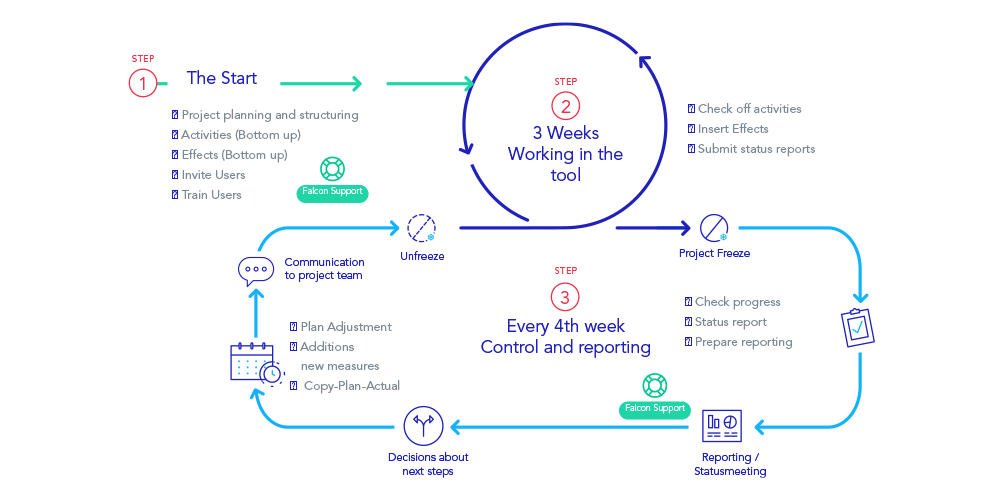In this article, we provide you with a standard definition, recommendations and best practice approaches on how to establish a meaningful governance that is in line with your strategic objectives.
Would you like to deepen your knowledge of project portfolio management?
The article "Project Portfolio Management - An Introduction For Practitioners With Little Time On Their Hands" is waiting for you with detailed information and analyses
Understanding the Essence of Governance
In the intricate tapestry of project portfolio management, a well-crafted governance is the cornerstone of success. For Project Management Office (PMO) members, creating a governance framework that seamlessly aligns with organizational objectives is both an art and a strategic imperative. This article unveils key insights and recommendations to guide PMO members in the artful creation of a governance framework that resonates with and propels strategic organizational goals.
Why have a Governance Framework at all? And who is responsible for creating it?
Governance in project portfolio management refers to the set of policies, procedures, and decision-making processes that dictate how projects - and the entire portfolio - are managed within an organization. It serves as the compass that ensures projects align with overarching organizational objectives, values, and standards. The latter is a key part of governance manuals - and for quite a simple reason: only if you follow some set of standards, you can compare projects against each other sensefully. That in turn, is the prerequisite of a purposeful aggregation of projects to a portfolio.
As custodians of project portfolio management excellence, PMO members are uniquely positioned to influence and shape the governance framework. However, project variance is vast. Finding a one-size-fits-all governance framework is hence rather challenging for the entire team. Check out what you probably should consider standardizing in the next section.
Key Components of an Effective Governance
A well-crafted governance comprises what you and your organization need to set as standards, to keep your project portfolio aligned and transparent. This may be different for each organization and its respective company culture, depending on the composition of the team. Yet there are a few things that most frameworks have in common.

Establish Strategic Fit
A governance should seamlessly align the project portfolio with the broader organizational strategy. PMO members must actively participate in strategic planning sessions, ensuring that project initiatives directly contribute to and reinforce the organization's objectives. A rather easy way to make sure this happens is to require projects contributing to at least one of the strategic goals.
Define Roles and Responsibilities within the team
Establishing clear roles and responsibilities is the foundation of effective governance. Define the duties of project managers, team members, sponsors, and other stakeholders. This clarity ensures accountability and sets the stage for streamlined decision-making. Make sure your own role - i.e. PMO tasks and responsibilities - are clear, too.
Define The Level Of Detail You Expect
Establishing the level of detail you require - especially when it comes to milestone planning - is paramount. Other than commonly believed, is often not more detail that is sensible, it is less.
Define A Stage Gate Process
This is a pretty broad topic in project portfolio management. But projects are usually in different phases during their lifecycle (e.g. from the idea to the realization phase). Make sure you select a suitable process that fits your needs.
Define A Risk Escalation Channel & Process
What happens if a project does not unfold as intended, and how is this information communicated and, if necessary or if certain risks occur, escalated? Everyone should know the proper channels at all times.
Define A Robust Reporting Cycle
The project cycle helps in establishing a successful routine for project portfolio work and will immediately increase the team's performance. There is hardly anything more important than the quasi-religious pursuit of this cycle. Only with this regularity can the project be well accompanied by the PMO, and issues can be addressed in a timely manner. Experience shows that without a strict cycle, transformations are almost always doomed to failure because they fall asleep. So make sure to choose a cycle and format (e.g. a monthly steering committee with C-Level involvement, PMO, and all project sponsors) that fits your needs. Find more on this very important step here.

Define A Robust Decision-Making Process for your PPM
Crafting a governance framework involves designing robust decision-making processes. Clearly outline how decisions will be made, who the decision-makers are, and the criteria guiding those decisions. This clarity minimizes ambiguity and accelerates the decision-making process.
Tailoring the Governance to Organizational Culture
Embracing Organizational Culture
Successful governance is rooted in an understanding of and alignment with the organization's culture. PMO members should tailor the governance to complement the existing cultural fabric, ensuring that it is embraced rather than resisted by the organization.

Communication Strategies
Effective communication is the lifeblood of governance. Establish transparent communication channels to disseminate governance policies, updates, and changes. Open dialogue fosters understanding and buy-in from all stakeholders, promoting a collaborative governance culture. A commonly used point in time to communicate the governance effectively is kick-off meetings. The kick-off is an art in itself - and we happen to have a little free-of-charge resource for you up our sleeves. Check for yourself!
Balancing Flexibility and Control
Adaptable Governance Structures
The best governance structures strike a balance between providing structure and allowing flexibility for different processes. PMO members should design governance structures that are adaptable to changes in project portfolio landscapes while maintaining sufficient controls to mitigate risks.
Continuous Monitoring and Improvement
Governance is a dynamic process that requires continuous monitoring and improvement. Implement mechanisms for regular assessments and reviews of the governance. Use feedback loops to identify areas for enhancement and ensure ongoing alignment with organizational objectives and the overall strategy.
Leveraging Technology for Governance Excellence
Implementing Project Portfolio Management (PPM) Tools
Technology, specifically Project Portfolio Management (PPM) tools, can significantly enhance governance efficiency and consequently the performance of your project portfolio. These tools provide a centralized platform for documenting, tracking, and managing projects. Automation streamlines workflows improves reporting accuracy, and facilitates real-time decision-making, even in bigger teams.
Data-Driven Insights
Leverage data-driven insights from PPM tools to inform governance decisions. Analyze performance metrics, resource utilization, and project outcomes to ensure that the governance remains adaptive and responsive to the evolving needs of the organization. Looking for more? Check out our interesting resource collection!
In Conclusion: A Roadmap to Governance Excellence
In the complex world of project management, the creation of a governance system is not a one-size-fits-all endeavor. PMO members, equipped with strategic vision and a deep understanding of organizational objectives, can sculpt a governance framework that not only enforces rules but also fosters a culture of collaboration and innovation.
By embracing clearly defined roles, aligning the project portfolio with organizational strategy, and balancing flexibility with control, PMO members pave the way for governance excellence. In doing so, they not only navigate the complexities of project portfolio management with finesse but also contribute significantly to the overall success and resilience of the organization. As the architects of effective governance, PMO members hold the key to unlocking the full potential of every project in alignment with the grand tapestry of organizational objectives.

